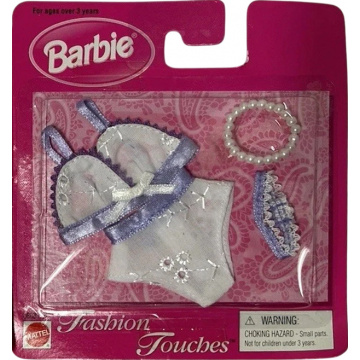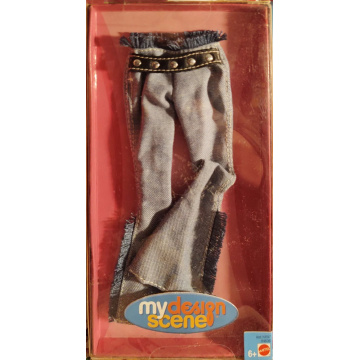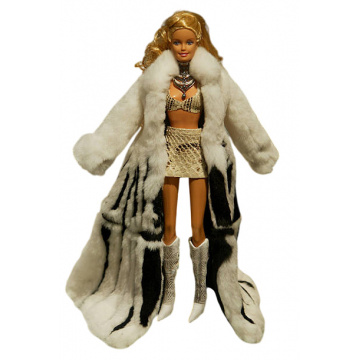Barbie Dolls by Decades
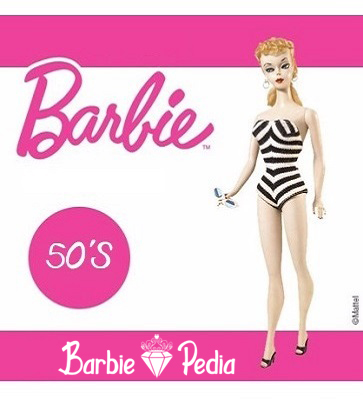
50's Decade
In the 1950s, most dolls made were childlike in appearance. Ruth Handler noticed that her daughter Barbara preferred adult-looking dolls and proposed to her husband to create a doll. Mattel rejected the proposal. On a trip to Germany, Ruth discovered a doll called Bild Lilli that was sold for men, Ruth again insisted Mattel accepted and bought the rights to Lilli.
In 1958 the original head mold was patented (it had a prominent, solid line at the height of the eyelashes) and Barbie (Barbara Millicent Roberts) was born, from Willows (a fictional town in the state of Wisconsin) where she attended Willows High School. It went on sale on March 9, 1959, a date that would later be her birthday.
All the products and dolls of the year:

60's Decade
In 1965 Barbie began to have legs that bend and in 1967 Twist Barbie was created, which moved from the waist up, as if to dance rock'n'roll.
In this same decade, friendships such as Barbie's boyfriend Ken (1961, Kenneth Carson), “Mod” Francie (1966) and family members such as Skipper (1964), Tutti (1966), her brother, Todd (1966) and two famous cousins.
Mattel also introduced other races, such as Francie AA in 1967, who is sometimes described as the first African-American Barbie doll. However, she was produced using existing molds for the white Francie doll head and lacked African-American characteristics other than dark skin. The first African-American doll in the Barbie range was known as Christie, who introduced her in 1968.
All the products and dolls of the year:
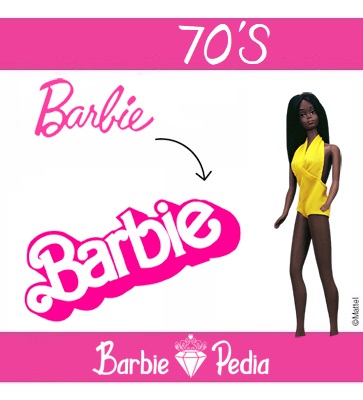
70's Decade
In 1970 there was a very glam Barbie, with a metallic coat, by 1971, sales had dropped significantly. It was already considered an outdated toy. Barbie was then given a complete makeover. Her hair became longer, thicker and blonder, she lost her ponytail and began to show her teeth in her permanent smile and look forward. Malibu Barbie was born, a doll with much tanner skin than the previous one and who wore as accessories a swimsuit, purple sunglasses, a small yellow towel and a surfboard, but no shoes.
The first logo was presented in March 1959 at the New York Toy Show, and was a cursive, handwritten font. In 1975 there was a big change in the logo using a volume with white filling and three-dimensionality in pink.
Barbie arrived in Spain in 1978, causing true devotion among the girls of the time.
See only the 70s dollsSee all by years:

80's Decade
In 1980, another version of the "Black Barbie" was released with very refined makeup, brown eyes and curly hair, but she still had too many Caucasian features.
Starting in the 1980s, a new Barbie series for collectors called Dolls of the World was born, which continually presents Barbies dressed in traditional attire and with characteristic ethnic features.
Between the 70s and 80s, Congost presented and marketed Barbie in the Spanish market. They manufactured their collection of dolls under the Mattel license, among which the Barbie Sun stands out, which is the inspiration for the later manufactured Barbie Famous and Barbie SuperStar.
See only the 80s dollsSee all by years:

90's Decade
In another attempt to get closer to African-American culture, in 1991, Mattel created an alternate line called “The Marvelous world of Shani”, with three new molds: Shani, Asha and Nichelle, which represented the different tones of black skin and characteristics; The line lasted only one year, some time later Shani appeared in two subsequent collections with Barbie, which are: Sun Jewelry and Jewel Glitter from 1993 respectively. As additional information, Asha's facemold would be Christie's face after 1997.
Barbie began to incorporate technological innovations into her dolls, the first Barbie doll was the "Teen Talk Barbie" in 1992. Mattel obtained several lawsuits for the messages that the dolls said.
See only the 90s dollsSee all by years:

2000's Decade
On January 1, 2000, the Silkstone series was born. Its editions are limited. The head mold used reproduces the original head mold, with modern makeup and clothing with high quality accessories. In March, the media claimed that the vinyl on the dolls was dangerous. Technical experts denied it. The modern doll has a body made of ABS plastic and a head made of soft PVC.
In 2002, “My Scene” appeared, larger dolls that represented a much younger age than Barbie.
In September 2003, Saudi Arabia banned its sale for not conforming to the ideals of Islam. There is a similar doll called Fulla, in Iran it is Sara and Dara. Barbie is available in countries like Egypt.
Since 2004, the Platinum Label (up to 1,000 u), Gold Label (up to 25,000 u), Silver Label (25,000-50,000 u) and Pink Label collection levels appeared. In 2007, Pink Ribbon and Pink Hope (Collector) were created to collaborate in the fight against breast cancer.
In April 2009, they launched the Totally Tatoo Barbie with "tattoos" for the doll and girls, one was a rear end and sparked controversy. A promotional quote prompted Ed Mayo (Consumer Focus) to say that he could make girls want to get (permanent) tattoos. In September, the So In Style (S.I.S) range was launched to create a more realistic representation of AA than previous dolls.
See all by years:

2010's Decade
In December 2010, the FBI considered the "Video Girl Barbie" doll dangerous due to the large number of pedophiles who could have access to its recordings made with the chest camera that recorded images (30 min) that could be downloaded with a USB cable. . In March 2015, the "Hello Barbie" doll held conversations through voice recognition and transmitted the data to the "ToyTalk" service, providing that information to third parties.
In 2016, the Barbie Fashionistas line was launched (“Toty” award) with bodies of different sizes and sizes: Original, Curvy, Tall and Petite with 7 skin tones.
See only the 2010s dollsSee all by years:

2020's Decade
In 2020, a global pandemic emerged caused by a virus called COVID-19 and known as Coronavirus. Despite this, sales increased considerably thanks to the “Barbie color reveal” and “Barbie extra” dolls.
Mattel created six dolls in honor of women who work in science, technology, engineering and mathematics from different parts of the world such as Professor Sarah Gilbert or the Brazilian biomedic Jaqueline Góes de Jesus, among others.
See only the 2020 dolls

